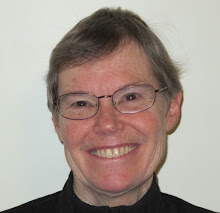As I ate a grapefruit today, I recalled childhood experiences with grapefruits. I wondered if I had already written about those experiences. Indeed I had. I found a copy of an article I'd submitted to the Danvers Herald in 2014. It remained online via "Wicked Local" for years.
Remembering Danvers: Eating grapefruit with a spoon

By Sandy Nichols Ward
Large family dinners at the Nichols homestead in Danvers often started with grapefruit. The long dining-room table (composed of a row of shorter tables covered with white tablecloths to resemble a banquet table) was set with silverware, glassware, and traditional blue and white china. At each place setting, centered on a small plate, was a golden half of grapefruit. We ate it with silver spoons that were about the size of teaspoons, but more pointy on the end. We called them "grapefruit spoons." Those spoons fit well into the triangular wedges of juicy fruit.
My earliest memories of grapefruit involve gift baskets of citrus fruit that arrived from Florida. My mother’s Aunt Catherine used to send us a basket each winter. I was confused about whether she lived in Florida; I thought she lived in New York. (I hadn’t yet learned about mail-order catalogs.) My mother was always delighted to receive this southern fruit, though it wasn’t exactly my idea of a Christmas present.
We ate the oranges and the grapefruit in the same manner: cut in half, and then each triangular section scooped out with a pointed spoon. My mother even had a set of spoons she called "orange spoons." Each spoon had her maiden initials, JNC, engraved on the handle, in various styles of lettering. She explained that as a child she had received one monogrammed spoon each year from an elderly relative; the style of the spoons matched, but sometimes the engravings didn’t match. No matter. We used her orange spoons for both the sweet oranges and the sour grapefruit.
I remember resisting the grapefruit one day, fearful that it would be too sour. My mother cheerfully encouraged me, saying, "Only the first three bites will taste sour." I immediately pushed my grapefruit towards her, asking her to eat those first three bites. I was very serious about this, taking her statement literally. She and my father laughed heartily, but I didn’t get the joke. I was upset that she wouldn’t help me by taking those first three bites!
Now as an adult I love the taste of grapefruit. Except for the danger of squirting juice onto my glasses or clothes, I enjoy digging out the grapefruit segments with a pointed spoon. My stainless steel serrated grapefruit spoons, however, are in sad condition. The plastic handles are mostly broken. The tip of one spoon was mauled years ago by falling in an automatic disposal unit in a sink. The handles of others were bent by a young guest who misused these spoons to dig hard-frozen ice cream from its container. Honestly, I ought to throw these worn-out spoons away and buy myself some better ones. That’s what I muttered to myself last month, between bites of succulent grapefruit.
Throwing anything away, however, is hard for an old New Englander, especially if you can continue to "make do" with the worn-out item. (I’ve been using these battered spoons for at least 40 years, so replacing them clearly isn’t high priority.)
Instead of shopping for new grapefruit spoons, I pursued other tasks on my "to do" list. I drove to a community where I used to live and stopped at the bank to investigate my safe deposit box. Since the fee for that box was about to increase, I wondered what was still in there and whether I’d need to renew the box rental. I hadn’t looked in years. To my surprise, I discovered a green cloth package enclosing various old silver spoons inherited by my father from that Danvers homestead. A scribbled note said "Pine Knoll items: save for Sandra and Tonya." Inside were six matching spoons with the monogram E.P.S. on the backside of the handles. Lovely pointed grapefruit spoons! I recognized the initials: Elizabeth Perkins Stanley, of Salem, known as "Lizzy" within her family. The spoons were made by "J.J. Rider" and stamped "Salem." It is likely that these were wedding gifts to Lizzy as she married Andrew Nichols of Danvers in 1861. He built their home at Pine Knoll (98 Preston St., Danvers) and they raised eight children there. I have now brought her spoons to my house and will think of my great grandmother Lizzy as I enjoy eating grapefruit with my "new" spoons.
